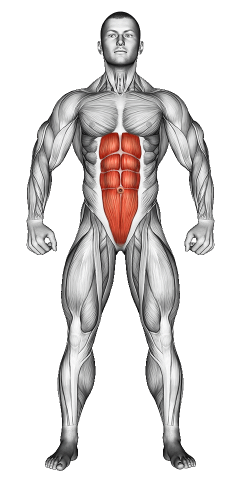Toe Touch Crunches: Video Tutorial & Exercise Guide

Written By: Claude Michael
Updated: Oct 13, 2024
| Workout | Toe Touch Crunches |
| Primary Muscle Group | Abs |
| Equipment Required | Bodyweight |
| Force Type | Pull |
| Mechanics | Compound |
| Exercise Type | Strength |
| Difficulty | Intermediate |
Toe Touch Crunches: Video Tutorial & Exercise Guide
- 1.Toe Touch Crunches: Muscle Groups
- -1.1Primary Muscle Group
- -1.2Secondary Muscle Group
- 2.Toe Touch Crunches: Step-by-Step Guide
- 3.Toe Touch Crunches: Overview
- 4.Toe Touch Crunches: Benefits
- 5.Toe Touch Crunches: Pro Tips & Advanced Techniques
- 6.Toe Touch Crunches: Progression Plan
- 7.Toe Touch Crunches: Frequently Asked Questions (FAQs)
Toe Touch Crunches: Step-by-Step Guide
- Step 1: Start by lying flat on your back with your legs extended straight up toward the ceiling. Your arms should be extended above your chest, palms facing each other.
- Step 2: Engage your core and lift your shoulders and upper back off the ground as you reach your hands toward your toes.
- Step 3: Exhale as you crunch upward, aiming to touch your toes while keeping your legs straight.
- Step 4: Slowly lower your shoulders back down to the mat with control, maintaining tension in your abs.
- Step 5: Repeat for the desired number of repetitions, keeping your core tight and movements controlled throughout.
Toe Touch Crunches: Overview
Toe Touch Crunches are a core-focused exercise that primarily targets the upper abs while also engaging the lower abs and obliques. This movement combines a crunch with a leg lift, requiring you to engage your core fully to lift your torso toward your toes. It’s an excellent bodyweight exercise for toning the abs and improving core strength.
This exercise can be performed anywhere with no equipment, making it a versatile and convenient addition to any ab workout routine.
Toe Touch Crunches: Benefits
Toe Touch Crunches are highly effective for strengthening the upper abdominals, helping to tone and sculpt the midsection. They also engage the lower abs and obliques, providing a comprehensive core workout. In addition to building core strength, this exercise can improve posture and stability, both of which are important for everyday activities and athletic performance.
The movement is low-impact and can be easily modified for different fitness levels, making it a great exercise for beginners and advanced athletes alike.
Toe Touch Crunches: Pro Tips & Advanced Techniques
To maximize the effectiveness of Toe Touch Crunches, focus on slow, controlled movements. Avoid using momentum to lift your shoulders, and instead rely on your core strength to perform the crunch. If you're looking to increase the difficulty, try holding a small weight or medicine ball above your chest as you reach for your toes.
Toe Touch Crunches: Progression Plan
Beginner
Intermediate
Advanced
Toe Touch Crunches: Frequently Asked Questions (FAQs)
What muscles do Toe Touch Crunches target?
+This exercise primarily targets the upper abdominals while also engaging the lower abs and obliques for full core activation.
Can beginners do Toe Touch Crunches?
+Yes! Beginners can start by performing the movement with a smaller range of motion and focusing on proper form. As core strength improves, they can increase the intensity.
How can I make Toe Touch Crunches more challenging?
+To increase difficulty, try holding a small weight or medicine ball above your chest or slowing down the tempo to increase time under tension.
How often should I include Toe Touch Crunches in my routine?
+Include this exercise 2-3 times per week as part of your core workout routine for optimal results in strengthening and toning the abs.
What common mistakes should I avoid during Toe Touch Crunches?
+Avoid using momentum to lift your shoulders and legs, and focus on engaging your core throughout the movement. Keep your back flat and avoid straining your neck by keeping your gaze upward.
Share
Don’t Wish for It, Work for It – Join the FlexXP Newsletter Today!
Thank you for signing up for the FlexXP Newsletter!
This site is protected and the Google Privacy Policy and Terms of Service apply.
